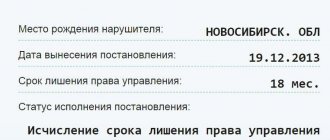Administrative liability is provided for failure to comply with the traffic rules of the Russian Federation. The law allows representatives of the State Traffic Inspectorate to remove a driver from driving a vehicle. This is one of the methods of administrative punishment. After being suspended from driving, a person will not be able to drive until the reason that led to the application of the measure is eliminated.
The grounds for removal from driving a vehicle are recorded in a resolution drawn up by traffic police officers. A person can be suspended from driving only in compliance with established standards.
What is a driving suspension?
The definition of the concept follows from the provisions of Article 27.12 of the Code of Administrative Offenses of the Russian Federation. Removal from driving a vehicle is a punishment for committing a number of administrative offenses, entailing temporary deprivation of the right to drive a car. The restriction can be imposed on the driver of any vehicle:
Attention! If you have any questions, you can chat for free with a lawyer at the bottom of the screen or call Moscow; Saint Petersburg; Free call for all of Russia.
- passenger car or truck;
- river boat;
- bus;
- tram;
- other vehicles.
Removal from driving is carried out to prevent more serious administrative offenses that could result from continued driving. A traffic police officer or other person monitoring compliance with Russian Federation traffic regulations has the right to apply punishment. The measure is temporary. Once the violation is corrected, access to driving will be restored.
What is the procedure and rules for removal?
The procedure is quite simple, and above we indicated the main points:
- you are stopped by a traffic police officer and found one of the grounds for removal from driving,
- further, he demands to stop driving and prohibits driving until the reason for the suspension is eliminated,
- At the same time, a corresponding protocol is drawn up,
- After the reason is eliminated, the inspector allows us to move on and wishes us a good trip.
Grounds and reasons
The list of grounds for applying suspension from driving a vehicle is given in Article 27.12 of the Code of Administrative Offenses of the Russian Federation. Punishment will be imposed on the offender in the following situations:
- The car is driven by a citizen who was previously deprived of the right to drive a car, and the deadline for returning the license has not yet arrived (Article 12.7 of the Code of Administrative Offenses of the Russian Federation).
- The representative of the State Traffic Inspectorate has reason to believe that the person is intoxicated. Moreover, it does not matter whether it is narcotic or alcoholic (Articles 12.8 and 12.26 of the Code of Administrative Offenses of the Russian Federation). The citizen will be asked to undergo a medical examination.
- A person operates a vehicle knowing that the brakes, clutch or steering are defective. This leads to danger for the owner of the car and other road users (Article 12.5 of the Code of Administrative Offenses of the Russian Federation).
- The citizen does not have a complete list of documentation with him, which must be in the car (Article 12.3 of the Code of Administrative Offenses of the Russian Federation). The list of required papers is presented in clause 2.1.1 of the Russian Traffic Regulations.
- The car is driven by a person who does not have a license (Article 12.7 of the Code of Administrative Offenses of the Russian Federation).
If a representative of the State Traffic Inspectorate suspects that the driver is drunk, the citizen is removed from driving the car and sent for examination. The reasons for making such a decision are:
- presence of the smell of alcohol;
- postural instability or inability to maintain an upright position;
- behavior inappropriate to the situation;
- the color of the skin is changed;
- impaired clarity of speech.
Continuing to drive in this condition may result in a serious accident. Therefore, even the most insignificant sign is taken into account.
The removal is carried out in the presence of two witnesses. If it was not possible to involve them in the proceedings, video recording is made. It is mandatory to draw up a protocol on removal from driving a car.
The examination is carried out in accordance with the standards of the Government of the Russian Federation No. 475 of June 26, 2008 and clauses 227-232 of the Administrative Regulations of the State Traffic Safety Inspectorate. Before the procedure begins, the traffic police officer must explain what he plans to do, as well as demonstrate the measuring device, presenting documents for it and showing that the stamp is intact.
Then measurements are made taking into account the instrument error. Based on the results of the procedure, an inspection report is drawn up. The document must be signed by witnesses, if present, the inspector and the driver.
If the driver does not agree with the results obtained, he may request an examination at a medical institution, where a traffic police representative must take the citizen. If intoxication is confirmed, the car will be taken to the impound lot. The exception is when there is someone to replace the driver. A citizen who has a license and is included in the MTPL insurance can take control of the car. In this case, the car will not be taken away.
If the examination does not confirm the fact of intoxication, the driver will be able to continue driving. A representative of the State Traffic Inspectorate is obliged to deliver the person to the place where the car was left.
What could be the grounds for suspension in 2021?
All of them are listed in the relevant laws, so the employee cannot invent his own reasons. Today, the grounds may be related to the following purposes of suppression:
- the driver is subject to suspension on the grounds that further movement of the vehicle under his control may create a danger to traffic,
- if such a danger can be created by the condition of the vehicle itself,
- the reason may be purely formal - the driver does not have documents with him, without which further driving is prohibited,
- the inspector just needs to use the car and get behind the wheel.
The first 3 reasons for removal from driving are listed in Article 27.12 of the Code of Administrative Offenses of the Russian Federation. And this is the most well-known normative act relating to this procedure. But many car enthusiasts believe that he is the only one. Not at all! There is also the Federal Law on Police, according to subparagraph 37 of paragraph 1 of Article 13 of which an employee of the Ministry of Internal Affairs has the right to suspend a driver if he needs to use his car for urgent purposes (for example, to deliver a person injured in an accident to the hospital).
But here, too, not everything is so simple for the employee. Below we will find out why. For now, let's look at the more specific grounds for removal one by one.
You will also be interested in:
- Can traffic police hide in the bushes under the new Order No. 664?
- Is it legal for a traffic police inspector to demand that he get out of the car?
- Who is responsible for the car if the driver is picked up by traffic police officers and taken away?
Intoxication and refusal of examination
This is the most common reason for using this procedure in 2021. Moreover, it is not the driver who is found to be drunk on alcohol or drugs, but the one who is only suspected of this, who is subject to suspension. That is, this event is carried out to determine reliably whether the driver is drunk and whether he is subject to punishment.
Please note that suspicion of intoxication is also clearly regulated by law. For example, if an inspector sees that the driver has red, watery eyes or trembling hands when handing over documents for inspection, then in this case the removal will be illegal, because the signs of intoxication are listed in a separate regulatory act - the Administrative Regulations, introduced by Order No. 664.
In particular, paragraphs 223 and 227.1 include the following criteria for removal:
- unstable position (for example, if the driver cannot stand still or staggers),
- smell of alcohol on the breath (another smell is no longer a reason),
- speech disorders,
- a sharp change in the color of the skin of the face (and not the neck, arms and other parts of the body),
- behavior that is inappropriate to the situation.
Yes, if the first 4 signs are quite clear, then the last one is often universal - you never know how an inspector will evaluate behavior that does not correspond to the situation... That is, removal can be recognized as legal in any case. Although, here too, autoblogger Yuri Panchenko provides sufficient reasons for the courts to consider such grounds more carefully.
In general, the examination for intoxication begins with the suspension. Any other beginning of this procedure is not based on the law in 2021 (neither an employee’s offer to breathe in his nose, nor to pee in a jar, nor others).
Please also note that a driver can be sent for a medical examination without being tested for alcohol on the road, and the reason may not be one of the above, but an accident with injured people. That is, in this case, the reason is the determination to initiate a case under Article 12.24 of the Code of Administrative Offences.
Driving without STS
Driving a car without a registration certificate (CTC) is another reason for removing the driver from the steering wheel. This is directly indicated by Part 1 of Article 27.12 of the Code of Administrative Offences. Thus, the correct order of action for the inspector here is:
- a traffic police officer stops you and discovers that you do not have a vehicle registration certificate,
- a resolution is drawn up against you under Part 1 of Article 12.3 of the Code of Administrative Offenses of the Russian Federation,
- then you are suspended from driving the vehicle - also with the appropriate protocol,
- and then another protocol is drawn up - the detention of the vehicle.
A total of 3 documents if you are charged with driving without a license.
Please note that in this case we are talking about the absence of STS with you or its loss. If, for example, you have not yet received it from the traffic police because you have not registered a new car, and the legal period of 10 days has expired, or the car has been deregistered, then in this case you are charged under one of the relevant other articles of the Code of Administrative Offenses (12.1 or 19.22).
And, if there is no prosecution specifically under Article 12.3, Part 1, then the application of removal from management against you by law is prohibited.
Driving without a driver's license
Suspension is applied in 2 more cases:
- if you do not have a license to drive a vehicle (you have never received a license or it has expired),
- your driver's license has been revoked.
That is, accordingly, if a decision is made against you under Part 1 or 2 of Article 12.7, you may be suspended. If you simply forgot it at home or lost your driver’s license (Part 2 of Article 12.3 of the Administrative Code), then this is not a basis for removing you from driving your vehicle.
Here, as above, after this event, the car is evacuated to an impound lot.
Machine malfunctions
The following 3 reasons are legitimate for using the procedure we are discussing:
- if your car has faulty brakes (except the handbrake),
- if the steering does not work (including power steering or electric power steering),
- or a towbar or other part of the coupling device when driving with a trailer.
This state of affairs is also regulated by the first part of Article 27.12 of the Code of Administrative Offenses of the Russian Federation, which refers to Part 2 of Article 12.5 as a basis for removal. As with the other reasons above, the car is moved to the impound lot.
Use of a vehicle by an employee
Another exotic basis for removal from driving a vehicle is one that few car owners know about. We are talking about the use of a car by a police officer. This right is given to him by Article 13 of the Law on Police and clause 6.14 of the Administrative Regulations of the Ministry of Internal Affairs, which duplicates its interpretation.
But, of course, not everything is so permissible for an employee. Thus, an employee can use vehicles owned by citizens only in the following cases:
- to stop a crime,
- if it is necessary to immediately pursue the person who committed it,
- you need to take the victim of an accident to the hospital,
- it is necessary to tow vehicles damaged in an accident,
- the employee needs to drive himself to the scene of a crime or administrative violation (including the scene of an accident).
And there is also an important condition here, which essentially determines this basis for removal solely for the reasons listed above - the driver, when using his car, must drive himself, if possible (clause 90 of the regulations). And this possibility is the absence of the conditions that are listed in Article 27.12 of the Code of Administrative Offenses as the main grounds.
Moreover, the driver subsequently has the right to reimbursement of expenses for such use - fuel and/or if material damage is caused to the car.
Normative base
Representatives of the State Traffic Inspectorate are guided by the provisions of the Traffic Regulations of the Russian Federation and Federal Law No. 196 of December 10, 1995 “On Road Safety”. If the rules enshrined in the above regulations are violated, punishment is imposed. The possibility of removing a driver from driving a vehicle is provided for in Article 27.12 of the Code of Administrative Offenses of the Russian Federation.
The conditions under which it is permissible to remove a driver from driving a vehicle are reflected in the following chapters of the Code of Administrative Offenses of the Russian Federation:
- ;
- ;
- ;
- ;
- .
Order and procedure according to the Code of Administrative Offenses of the Russian Federation
This punishment is an administrative measure, the application of which is enshrined in the Code of Administrative Offenses of the Russian Federation. The procedure and grounds for temporary removal from driving a vehicle are set out in Article 27.12 of this Code.
The decision can only be made by the traffic police inspector, drawing up a protocol.
The procedure for an inspector's actions when suspending citizens from driving is enshrined in paragraphs 223-226 of the administrative regulations of the State Traffic Safety Inspectorate:
- A prerequisite is the presence of two witnesses, or their replacement with a full video recording of the entire process of drawing up the protocol and making a decision.
- Next, the drawing up of a protocol on the driver’s suspension begins. Then, it is signed by the offender and the person driving. If a citizen refuses to sign, this decision is recorded in the protocol.
- A copy of the protocol is prepared and handed to the violator.
Procedure for removal from driving a vehicle
The process of removal from driving a car is carried out in accordance with the norms of clauses 223-226 of the Administrative Regulations, approved by Order of the Ministry of Internal Affairs of the Russian Federation No. 664 of August 23, 2021.
If grounds have been identified that allow the measure to be applied, a representative of the State Traffic Inspectorate will draw up a protocol. The document is drawn up in the presence of two witnesses - disinterested persons involved to certify the procedure being carried out. The person playing this role must be of legal age. Only uninterested persons can act as witnesses. Their participation is recorded in the minutes. If the case comes to trial, the witness may be questioned as a witness (Article 25.7 of the Code of Administrative Offenses of the Russian Federation). If there are no witnesses, video recording is allowed (Article 27.12 of the Code of Administrative Offenses of the Russian Federation).
The protocol contains the following information:
- stopping place;
- date and time of detention;
- personal information of the driver and traffic police officer;
- reason for removal from management.
When the paper is completed, a representative of the State Traffic Inspectorate signs it and hands it to the detained driver. The citizen must familiarize himself with the document. If all points are true, the driver will be asked to sign a document. A citizen has the right to refuse to carry out manipulation. In this case, a mark is placed at the place of signature confirming the fact of refusal. A copy of the completed protocol is provided to the offender.
The car is taken to the impound lot. It will remain here until the violation is corrected. The procedure can be avoided if a citizen is present who can replace the driver removed from driving. People who have a driver's license and registered insurance have the right to drive. The person must arrive at the place where the offense was registered before the vehicle is towed to the impound lot. Otherwise, you will have to pick up the vehicle in the standard manner.
Removal from driving and prohibition of operating a vehicle
The violations listed in the previous paragraph imply not only removal from driving, but also prohibition of operation. The procedure involves the evacuation of the car to the impound lot. The process is carried out in compliance with the provisions of Article 27.13 of the Code of Administrative Offenses of the Russian Federation. The legal act states that the decision to carry out the procedure is made by persons who can prepare protocols. Usually these are traffic police officers. A detention report must be drawn up.
If a ban on the operation of a vehicle is adopted due to the fact that the driver was intoxicated or deprived or does not have the right to drive a car, the detention can be terminated if there is a person nearby who can drive the car and is ready to take control of the vehicle . If the cause is a breakdown or other violation, the situation is ambiguous.
Drawing up a protocol on suspension from driving a vehicle
The protocol is drawn up in accordance with clause 225 of the Administrative Regulations of the Ministry of Internal Affairs. It is recommended to use a sample to complete the document. It is reflected in provision No. 14 of the above-mentioned legal act. The State Traffic Inspectorate employee who stopped the offender has the right to draw up a protocol on suspension from driving a vehicle. The document reflects the following information:
- The time the offender was detained and the place where the vehicle was stopped. If the situation occurred in a populated area, the street and number of the nearest building are recorded. When a violator is stopped on a highway, its name, kilometer number and other features that allow the location to be identified are indicated.
- The reason that led to the decision to remove the driver from driving the vehicle.
- Information about the State Traffic Inspectorate employee who compiled the protocol. The document records the position, rank, division to which it belongs, as well as the full name.
- Information about the driver against whom administrative punishment is applied. The protocol form includes your full name, date and place of birth, residential address, employment information, telephone number for operational communication.
- Information about witnesses. The inspector will write down your full name, place of residence and telephone number.
The driver can monitor the preparation of the protocol. Providing false information or failure to comply with the rules for removal from management may be grounds for invalidating the document.
The protocol on suspension from driving a vehicle can be found here.
If a person has committed an offense, but a report has not been drawn up, it will not be possible to bring the person to justice. Clause 225 of Order No. 664 of the Ministry of Internal Affairs of the Russian Federation prescribes the mandatory execution of a document. If a person is openly drunk, and a representative of the State Traffic Inspectorate does not remove him from driving a car, the representative of the authorized body may be accused of negligence.
Features of drawing up a protocol
protocol on removal from driving a vehicle
You should carefully read the protocol drawn up and the referral for the medical examination procedure.
The following information is entered into the protocol:
- time and place of detention. A specific section of the road is identified,
- the basis for the suspension and referral of the driver for a medical examination,
- information about the compiler of the protocol, including his position,
- information about the vehicle involved in the case.
To draw a conclusion about the correctness of the protocol, it is recommended to familiarize yourself with the sample, which is freely available on the Internet.
ATTENTION! Look at the completed sample protocol on removal from driving a vehicle:
Watch the video. About the protocol on suspension from driving a vehicle:
Driver's rights and responsibilities
The rights and responsibilities of drivers arise from the rules of traffic rules, the Code of Administrative Offenses of the Russian Federation, as well as other legal acts. A person may:
- Require the drawing up of a protocol only in the presence of witnesses or during video filming. Failure to follow the rule is considered a violation.
- Ask to provide all materials compiled during the registration of an administrative offense.
- Request an examination at a medical institution if removal from control is carried out due to suspicion of intoxication.
The driver is obliged to comply with the traffic rules of the Russian Federation, present, at the request of a representative of the State Traffic Inspectorate, his license, documents for the car and insurance, and not interfere with the drawing up of a protocol and placing the car in the impound lot.
Procedure for suspension from driving a car
Traffic police officers and other similar law enforcement agencies have every right to take certain measures regarding the driver and remove him from subsequent driving of the car.
The general sequence of actions is structured in such a way that it is impossible to do without the presence of two witnesses.
These are witnesses who must be present in the process of drawing up such a document as a protocol on suspension from driving a vehicle, with the obligatory designation of the place, date and time of detention of the driving driver, as well as the personal data of the employee himself and the reason for the suspension.
Upon completion of the document, the protocol must be signed by the traffic police officer and the detained driver. It is worth noting that the driver has the right to refuse to sign the document, then at the place of the signature there will be a special mark confirming the refusal.
As an additional document, the result of the medical examination is attached to the completed protocol . Traffic police inspectors try to do their job as quickly as possible, trying to leave one lawbreaker and move on to another.
The procedure for checking the level of alcohol intoxication can delay the procedure for removing someone from driving a vehicle, since a special measuring device is not always available.
In this case, the driver is quickly taken to the nearest checkpoint, where all the required equipment is present . This raises the problem associated with the fact that the inspection is carried out at the checkpoint, but the car remains at the place of detention.
This is not the right situation! The inspector must initially carry out the removal procedure without an examination, and do this in front of witnesses. First, a protocol is drawn up, and then you are allowed to leave the stopping place.
Many specialists do not comply with these requirements and rules, relying on the basic lack of knowledge of standard drivers.
If such a situation occurs, it is worth inviting a competent, experienced lawyer who, through the court, will prove the erroneous and unlawful actions of traffic police officers.
In court it will be necessary to note that the protocol was drawn up at the post where the examination took place.
Meanwhile, the car was in a different place, so the driver can claim that he simply did not use his vehicle, but acted as a pedestrian.
To make it easier to prove in court the right to continue the process of driving a car, you need to pay attention to the fact that the car was not in sight at the time the case was filed.
And according to the law, if the vehicle was not in place, then the driver may not be accused of anything.
The court may also deal with other situations related, for example, to incorrect filling out of the protocol. If the traffic police officer provided inaccurate data or forgot to put the date, the decision can also be challenged.
What happens to the car?
If a citizen is suspended from driving a car, the vehicle will be detained. The rule is enshrined in Art. 27.13 Code of Administrative Offenses of the Russian Federation. Part 1 of the above-mentioned legal act provides an exhaustive list of cases in which the measure is applied. All situations that entail disqualification from driving a vehicle are also included in the list.
The process of detaining a car itself is regulated by paragraphs 244-257 of the Administrative Regulations, approved by Order of the Ministry of Internal Affairs of the Russian Federation No. 664 of August 23, 2021. The decision to apply a measure is made by officials who have the right to draw up protocols. The corresponding document is drawn up upon the fact of the detention of the car before it begins to move to a specialized parking lot. If the reason for the detention is eliminated, the evacuation process immediately stops. When the car is outside a populated area, it will be delivered to the nearest city.
A report on the detention of a car is drawn up in the presence of two witnesses. If they cannot be attracted, video recording is used. When the form is filled out, the State Traffic Inspectorate employee signs the document and offers the violator to carry out a similar procedure. If the driver refuses to carry out the action, a note to this effect is made in the protocol. A copy of the paper is given to the violator and the person involved in executing the decision to detain the car. The car owner will be informed where the vehicle will be stored.
How to regain the ability to drive a car
The period of suspension from driving a vehicle is influenced by the reason why this measure was applied:
- if the reason is the absence of a registration certificate, you should return for it and present it to the traffic police officer. In this case, there is a high probability that the car will be towed. In this case, the vehicle will need to be picked up from the impound lot, having paid for its maintenance in the parking lot and for evacuation,
- If the reason for suspension is a technical problem with the vehicle, troubleshooting on site is acceptable. After the repair is completed, the driver will be able to drive the car again,
- if the reason for the suspension is the lack of a driver’s license, then only the person who possesses it will be able to pick up the vehicle,
- if the reason for suspension is the driver’s state of alcoholic intoxication, then it is possible to return to driving only after complete removal of alcohol from the blood,
- If the reason for suspension is the lack of a driver’s license, then after presenting the document the driver will be able to drive again. To save money and prevent the car from being towed, you should ask relatives or friends to bring the ID to the place of detention.
The right to drive a vehicle can be returned only after the reason for such suspension has been eliminated.
Watch the video. Refund of license for driving a vehicle while intoxicated:
The process of returning a car from the impound lot
When the violation is corrected, the citizen will be able to pick up the vehicle. The decision to return the car is made by persons who have the right to draw up reports on administrative offenses (Part 3 of Article 27.13 of the Code of Administrative Offenses of the Russian Federation). It is not necessary to pay for evacuation services immediately.
Previously, it was impossible to get a car without paying the required amount. Now it is enough to eliminate the reason for the detention in order for the car to be returned. Federal Law No. 205 of June 23, 2021 made similar adjustments to the legislation.
The step-by-step instructions for returning a car from the impound lot are as follows:
- The citizen takes with him a driver’s license, compulsory motor liability insurance policy, and PTS and contacts the traffic police department.
- The inspector checks the documentation and makes sure that the violation has been eliminated.
- The applicant is provided with a notification certificate allowing him to retrieve the car from the impound lot.
- After collecting the documents, you need to visit the impound lot where the vehicle was delivered. By presenting the papers, the citizen will receive the car back.
How to pick up a car after being removed from driving?
You can pick up the car only after the violation has been eliminated. A decision on return must be made. Only persons who have the right to prepare protocols can carry out the action (Part 3 of Article 27.13 of the Code of Administrative Offenses of the Russian Federation).
Attention
There is no regulation obliging a citizen to immediately provide money for towing and leaving the car in the impound lot. Previously, the car was not given away without completing the procedure. However, Federal Law No. 205 of June 23, 2021 changed the existing standards. The vehicle can be returned just like that.
If a person wants to get his car back from the impound lot, he must proceed according to the following scheme:
- Prepare a package of documents. You need to take your driver's license, MTPL insurance, and vehicle registration certificate with you.
- Visit the traffic police and wait until the documentation is checked. The inspector's task is to make sure that the violation has been eliminated.
- Receive a notification certificate. The document gives the right to pick up the car.
- Visit the impound lot and present documentation. You need to have a certificate, PTS, license, and insurance policy with you.
- Pick up the car.
What to do if the suspension from driving a vehicle was unlawful?
If a citizen believes that the traffic police officers acted unlawfully, they can try to appeal the suspension from driving. Filing a complaint is permissible if a violation of rights and freedoms has occurred and the applicant has been unlawfully prosecuted. The list of authorities ready to consider the driver’s appeal is reflected in Art. 53 Federal Law No. 3 of February 7, 2011 “On the Police”. The application can be sent to:
- to a higher official;
- to the prosecutor's office;
- to court.
Clause 246 of the Administrative Regulations of the Ministry of Internal Affairs provides for the possibility of filing a complaint by calling the traffic police hotline. To use it, you need to call 8(800)-222-74-47. If a person plans to file a classic paper complaint, it can be submitted to the authorized body in person or sent by mail.
Complaints about illegal suspension from driving can be found here.
The complaint indicates the address of the sender, records data for operational communication, describes the nature of the illegal actions of the traffic police officer, and also provides grounds confirming the presence of a violation. The person then makes demands. At the end of the document there is a date and signature.
Grounds for removal
What is a driving suspension? This is a standard, legally enforceable driving ban.
According to Article 27 12 of the Code of Administrative Offenses of the Russian Federation, the following purposes and grounds for removal may become the basis for the complete removal of a driver from driving his vehicle:
- Malfunction of the vehicle used - damage to the brake system, failure of the steering mechanism.
- The driver is in a tipsy, intoxicated state, as well as under the influence of narcotic and toxic components.
- If the driver is a prisoner who has escaped from responsibility and is required to serve another term of imprisonment.
- Requirement for law enforcement officers to use a vehicle for special official purposes.
- The driver does not have transport documents, as well as a standard driver’s license.
- Deprivation of rights.
The most common reason for suspension is the alleged presence of a certain amount of alcohol in the blood of the person who was driving.
At the very beginning of the examination, traffic police officers are not able to accurately determine the level of intoxication of the person who was driving the vehicle. Despite this, they are obliged to check it at the slightest suspicion.
Among the primary signs of intoxication are:
- strong smell of alcohol;
- impaired clarity and clarity of speech;
- inability to stand.
The consequence of such a condition can be a serious car accident, which can lead to quite serious tragic consequences.
It is for this reason that any sign, even the most insignificant, is necessarily taken into account by traffic police officers.
If their suspicions regarding intoxication are confirmed, the person is automatically removed from driving the car.
Each drunk driver is first suspended from driving a car, then an official examination is drawn up, according to which the driver is sent to a standard medical examination process.
There, a “diagnosis” is established more accurately and the degree of intoxication is determined. Based on the results obtained from doctors, it becomes clear whether the person needs to be held accountable or whether the reason for the poor condition lies elsewhere.
The complete removal of the driver from driving a vehicle is carried out strictly in the presence of witnesses who will take responsibility for confirming the legality of the actions of the traffic police officers.
There is an opinion that a person who is stopped for a check does not have to leave his car. Modern legislation allows you to hand over the ignition keys to a traffic police officer and allow him to check everything that may not suit him.
As practice has shown, few people use this rule, since few people have the desire to pretend to be a proud bird, but control the actions of traffic police officers.
Many people are aware of their illegal actions, including special fraudulent actions. It is for this reason that it is so important to know how detachment occurs.
Nuances
In practice, motorists often confuse suspension from driving with deprivation of a driver's license. From a legal point of view, the concepts are radically different. The first measure is considered temporary. It is enough to eliminate the reason that served as the basis for making the decision in order to regain the ability to drive a car.
Getting your license back after deprivation is more difficult. The citizen will have to wait until the end of the deprivation period, comply with all legal requirements depending on the root cause, or challenge the decision.
Rights can only be taken away by court decision. The inspector has the right to remove you from driving a car. Moreover, lengthy proceedings are not carried out. The decision is made on the spot.
Rights of an accused driver
If a driver can be legally classified as a violator, but a protocol regarding the recorded violation has not been drawn up, it will not be possible to hold him accountable.
This rule does not apply to situations where the driver was obviously drunk and could become a real threat to other drivers or pedestrians.
In such a situation, the inspector who violated the order will simply be accused of negligence, and the proceedings will continue.
Drivers, as soon as the suspension procedure appears, may forget about their inherent rights. You need to know about them to avoid unfounded accusations.
Here are the most basic of them:
- the detained driver has the right to request an official medical examination to determine the level of alcohol in the blood in a regular department of the city clinic;
- if the driver did not have documents at the place of detention, he has the right to demand that they be brought and even go for them himself. It all depends on the time available to the traffic police officer;
- in the completed protocol, the driver must describe the full version of everything that happened, as well as indicate his legal explanations;
- removal from driving a vehicle without witnesses is unacceptable;
- In the process of registering a violation, each driver has the right to demand copies of all compiled materials or ask for a lawyer for himself.
The most important thing is to understand that the driver, like any citizen of the Russian Federation, has not only responsibilities, but also rights. This will help prevent illegal removal from driving a car.











